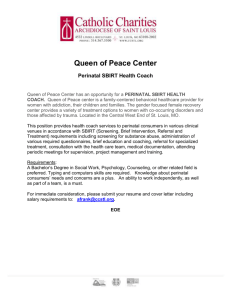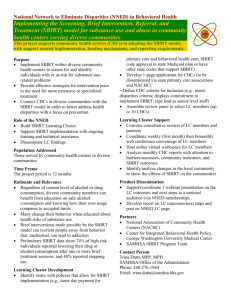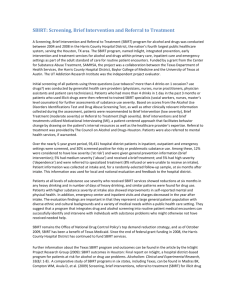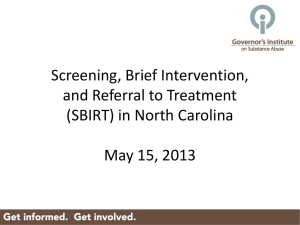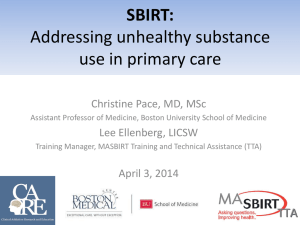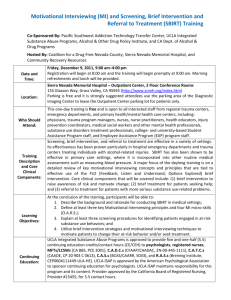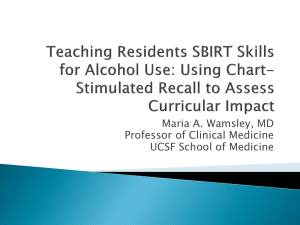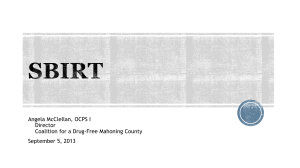Brief Intervention Stages of Change and Motivational Interviewing
advertisement
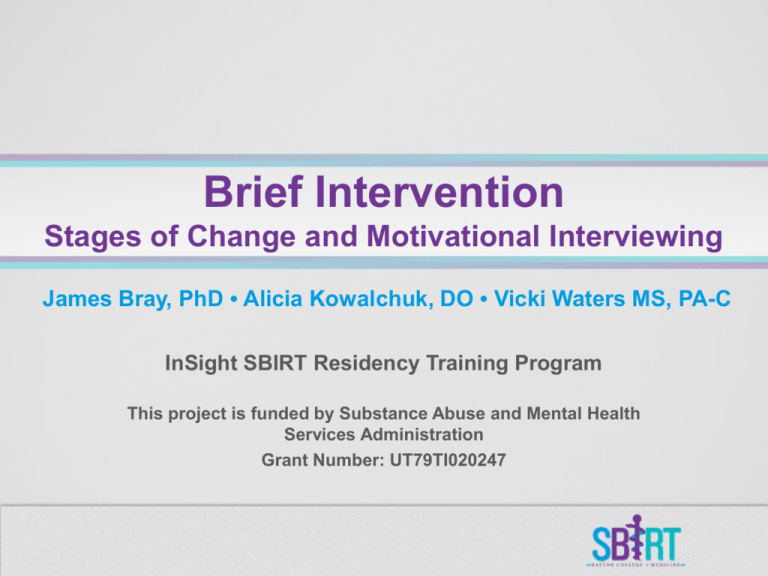
Brief Intervention Stages of Change and Motivational Interviewing James Bray, PhD • Alicia Kowalchuk, DO • Vicki Waters MS, PA-C InSight SBIRT Residency Training Program This project is funded by Substance Abuse and Mental Health Services Administration Grant Number: UT79TI020247 Learning Objectives Explain the Stages of Change Model for use in SBIRT Understand how to apply the stages of change in clinical practice Explain Motivational Interviewing as a method for effective physician – patient communication Discuss the processes of change SBIRT: Brief Intervention 2 Stages of Change • The Transtheoretical Model • Prochaska & DiClemente, 1984 • 6 stages of change, leading to successful behavior change • Non-linear process similar to stages of grief • 10 processes of change – Experiential (5) – Behavioral (5) SBIRT: Brief Intervention 3 Stages of Change Stage Characteristic Your Goal Precontemplation No intention to change behavior. Unaware or under-aware of problems To get patient to consider they have a problem Contemplation Aware of the problem & seriously considering a change, but no commitment to take action To raise awareness of problem by observation of behavior Preparation Patient intends to change and makes small behavioral changes To encourage these steps and support change process; Commit to make change a top priority Action Patient decides to take decisive action to change To make action plan suggestions, reinforce changes, provide support and guidance Maintenance Work to prevent relapse and consolidate gains To support continued change and help with relapse prevention SBIRT: Brief Intervention 4 PROGRESS Precontemplation NO FIRM COMMITMENT TO CHANGE Contemplation Preparation Action FIRM COMMITMENT TO CHANGE SBIRT: Brief Intervention Maintenance RELAPSE 5 Goals by Stage Relapse Precontemplation Contemplation Preparation Action Maintenance SBIRT: Brief Intervention Build commitment to change Make a plan for change 6 Motivational Interviewing (MI) Directive, client-centered style for eliciting behavior change by helping clients to explore and resolve ambivalence Miller & Rollnick (1991) Goal-directed Includes specific strategies, skills, approaches based on a general understanding of helpful interactions with patients (MI Spirit) SBIRT: Brief Intervention 7 The MI Spirit Collaboration Patient is own expert; Physician creates atmosphere that is conducive rather than coercive, and built on partnership Evocation Patient has resources and motivation to change within; Physician must evoke this from patient Autonomy Patient has right and capacity for self-direction; Physician respects and affirms this SBIRT: Brief Intervention 8 The Opposite Confrontation (Collaboration) Education (Evocation) Authority (Autonomy) SBIRT: Brief Intervention Patient is seen as impaired, unable to understand situation; Physician imposes “reality” of situation Patient is assumed to lack knowledge necessary for change to occur; Physician enlightens patient by forcing education Patient is assumed to lack capacity for selfdirection; Physician tells patient what he/she must do 9 The Four Principles of MI Principle Goal I. Build rapport Express Empathy II. Develop Discrepancy Elicit pros and cons III. Roll with Resistance Respect patient autonomy Communicate that patient is IV. Support Self-Efficacy capable of change SBIRT: Brief Intervention 10 Principle I: Express Empathy Acceptance facilitates change Reflective listening is fundamental Ambivalence is normal Goal: build rapport http://blog.bioethics.net/2009/03/what-are-doctors-asking-teen-patients-about/ SBIRT: Brief Intervention 11 Principle II: Develop Discrepancy Patient rather than physician should bring up reasons for behavior change Change is motivated by a discrepancy between patient’s perceived goals and values versus current behavior Goal: Elicit pros and cons of behavior SBIRT: Brief Intervention 12 Principle III: Roll with Resistance Physician avoids argumentation and persuasion, which pushes patient in opposite direction Patient invites new perspectives; physician does not impose them Client provides answers and solutions Resistance is a SIGNAL for physician to respond differently Goal: Respect patient autonomy SBIRT: Brief Intervention 13 Principle IV: Support Self-Efficacy Patient’s belief in possibility to change is key motivator Patient is responsible for achieving goal Physician asserts to patient this responsibility and thus supports them in their ability to achieve goal Goal: Communicate that patient is capable of change SBIRT: Brief Intervention 14 MI: Key Skills OARS – Open-ended questions – Affirming and supporting – Reflective listening – Summarizing SBIRT: Brief Intervention 15 Open-Ended Questions Allow patient to express own views while physician follows patient’s perspective Avoids yes/no answers Example: – “What negative consequences have you experienced as a result of your drinking?” As opposed to: – “Have you experienced negative consequences from drinking?” SBIRT: Brief Intervention 16 Affirming and Supporting Actively listen for patient strengths, values, aspirations, positive qualities Reflect those to client in affirming manner Example: – “You were able to lose weight before because of your perseverance and determination. Those strengths can help you quit smoking.” As opposed to: – “Realistically, its going to be hard for you to quit smoking.” SBIRT: Brief Intervention 17 Reflective Listening Mirrors what patient says in non-threatening manner Collaborative and nonjudgmental Deepens the conversation Helps patients understand themselves Want to avoid overstating or understating Use language of patient or similar language SBIRT: Brief Intervention 18 Summarizing Interim summaries used throughout Meeting ends with strategic, collaborative summary May – Reinforce patient’s motivation to change – Highlight realizations – Identify transitions, progress or themes SBIRT: Brief Intervention 19 MI and Change MI – evidenced-based approach to facilitating positive behavior change – Addiction – Weight-management – Diabetes – Anger management – Medication compliance MI relies on Transtheoretical Model of Change SBIRT: Brief Intervention 20 The Brief Intervention Perform the decisional balance Assess patient’s readiness for change Match appropriate brief intervention based on readiness for change SBIRT: Brief Intervention 21 Decisional Balance Motivational tool Start with – “What do you like about drinking/using___?” Then – “What do you not like about drinking/using___?” End with – Summary of pros and cons • Use patient’s terms to reflect back what they said • Start with pros, end with cons • Do not add your own cons SBIRT: Brief Intervention 22 The Readiness Ruler “On a scale of 0 to 10, how ready are you to stop drinking?” Not at all 0 1 2 3 4 5 6 7 8 9 10 Very Score Readiness Stage of Change 0-3 Not Ready Pre-contemplation; Early contemplation 4-7 Unsure Contemplation 8-10 Ready Preparation; Action SBIRT: Brief Intervention 23 Using the Readiness Ruler Scores 0-3 Elicit patient’s perceived negative consequences “What kinds of things have happened while drinking that you later regretted?” SBIRT: Brief Intervention Express concern “I am concerned about how smoking is contributing to your asthma.” Offer information Support and follow-up “Would you like more information about the effects of cocaine use on your health?” “I understand you aren’t ready to talk about your drinking and that’s ok. I would like to ask about it again at our next appt. Is that ok? Please call if you have any questions.” 24 Using the Readiness Ruler Scores 4-10 Elicit patient’s motivation to change Why a 5 and not a 2? Why a 5 and not a 9? SBIRT: Brief Intervention 25 Using the Readiness Ruler Scores 4-7 Negotiate a plan to cut back or quit Offer support & Follow-up “What are some steps you think you could take to start cutting back?” Support patient’s autonomy and ask about following up. SBIRT: Brief Intervention 26 Using the Readiness Ruler Scores 8-10 Help patient develop action plan Identify resources Instill hope “What would change look like for you?” “Let’s identify the steps necessary to help you stop smoking. What would be your first step?” “Who’s been supportive of you before? How can he or she help you stop drinking? “You’ve been successful in getting your diabetes under control, so you have the ability to stop using cocaine.” SBIRT: Brief Intervention 27 Readiness to Change & Intervention 0 1 2 Limited intervention Scores 0-3 Elicit perceived negative consequences, Express concern, Offer information, Support & follow-up SBIRT: Brief Intervention 3 4 5 6 7 8 9 10 Elicit patient’s motivation to change Scores 4-7 Scores 8-10 Negotiate a plan to cut back or quit, Offer support & Follow up Help patient develop action plan, Identify resources, Instill hope 28 Video & Discussion SBIRT: Brief Intervention 29 Badgecard Readiness Ruler SBIRT: Brief Intervention 30 Badgecard - Scripts Brief Intervention SBIRT: Brief Intervention 31 Let’s Practice 1 Patient 1 Provider • Each card has 1 • Follow instructions alcohol (front) and 1-5 on case card 1 drug case (back) • Pick one case • All patient specifics are on card SBIRT: Brief Intervention 32 InSight SBIRT Residency Training Program Contact Information: (713) 798-7751 James H. Bray, Ph.D. Project Director jbray@bcm.edu SBIRT: Brief Intervention Alicia Kowalchuk, D.O. Assistant Project Director aliciak@bcm.edu Vicki Waters, MS, PA-C Core SBIRT Faculty vwaters@bcm.edu Larry Laufman, Ed.D. Project Evaluator llaufman@bcm.edu Elizabeth Shilling, Ph.D. Research Coordinator ehshilli@bcm.edu Nadallie Lopez Administrative Assistant nalopez@bcm.edu Ygnacio Lopez, M.S., M.S. Ygnacio.LopezIII@bcm.edu 33
